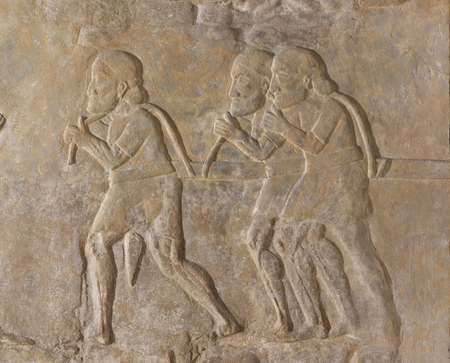Construire une ville

The short-lived capital of the Assyrian king Sargon II, Khorsabad is today best known for the impressive architectural decorations of its palace, such as protective winged bulls and court scenes. The Khorsabad collections are kept at the Musée du Louvre.

Founded by Sargon II, king of Assyria, the city of Khorsabad, formerly Dur Sharrukin, covered 300 hectares and was home to a magnificent palace. It was discovered in 1843 by Italian-born Paul-Émile Botta and was the first Mesopotamian site to be the subject of major archaeological excavation.
In 717 BCE, the Assyrian king Sargon II laid the foundations for a new capital, Dur Sharrukin - literally the "fortress of Sargon". He had a grandiose palace built high on a vast terrace that straddled the city fortifications, protected by a wall. Temples and residences for dignitaries were also built in the citadel. This construction project, which drew labour from every province of Assyria, took just under a decade to complete. In 714 BCE, Sargon’s 8th military campaign, which ended in the looting of the city of Musasir in Urartu, made a major financial contribution to this massive undertaking.
The palace is famous for its monumental decoration composed of winged bulls with colossal human heads placed as guardians on either side of entrances and passages, and its stone reliefs carved with protective genii and narrative scenes depicting processions of servants and tributaries, and hunting or war scenes.
Although his palace was inaugurated in 706 BCE, Sargon did not enjoy it for long. He died a year later on a military campaign. His body was never found and the lack of a proper funeral was interpreted by his son and successor, Sennacherib, as a bad omen. He left the city for Nineveh, the last Assyrian capital, where he was already resident as Crown Prince. Dur Sharrukin was sparsely occupied and gradually fell into oblivion until rediscovered more than 2000 years later.
The first excavations between 1843 and 1855 were conducted by French consuls Paul-Émile Botta and Victor Place. The Oriental Institute of Chicago resumed the excavations from 1929 to 1935 under the direction of Edward Chiera, Henry Frankfort, and Gordon Loud. An Iraqi team supervised by Fuad Safar opened the site again in 1957.
Works from Khorsabad form a core of the Mesopotamian collections of the Department of Near Eastern Antiquities at the Musée du Louvre.
Combating the theft and illicit trafficking of cultural property is one of the priorities of the French Ministry of Culture, which pays close attention to these issues, in line with its regulatory responsibility to control the movement of cultural property.